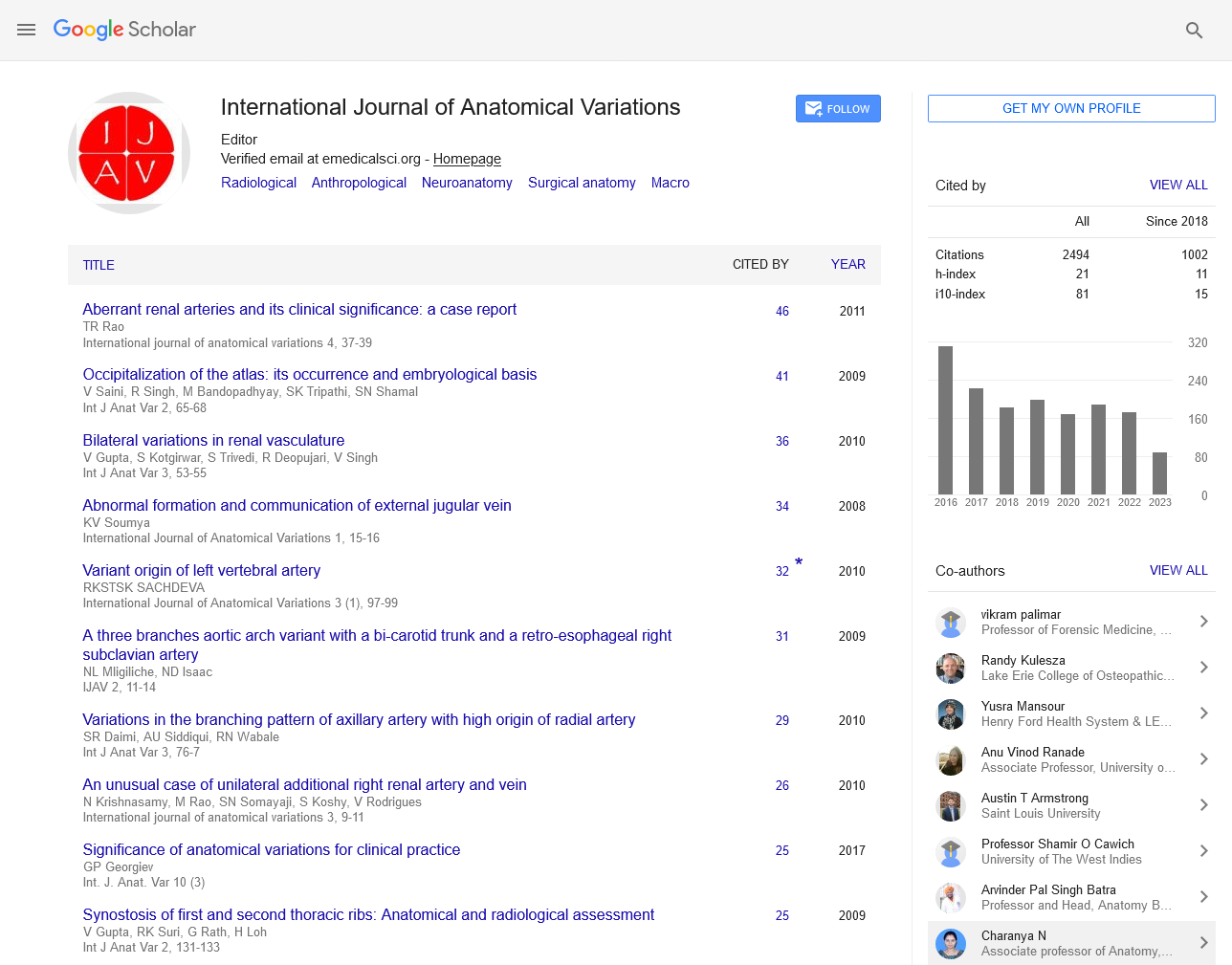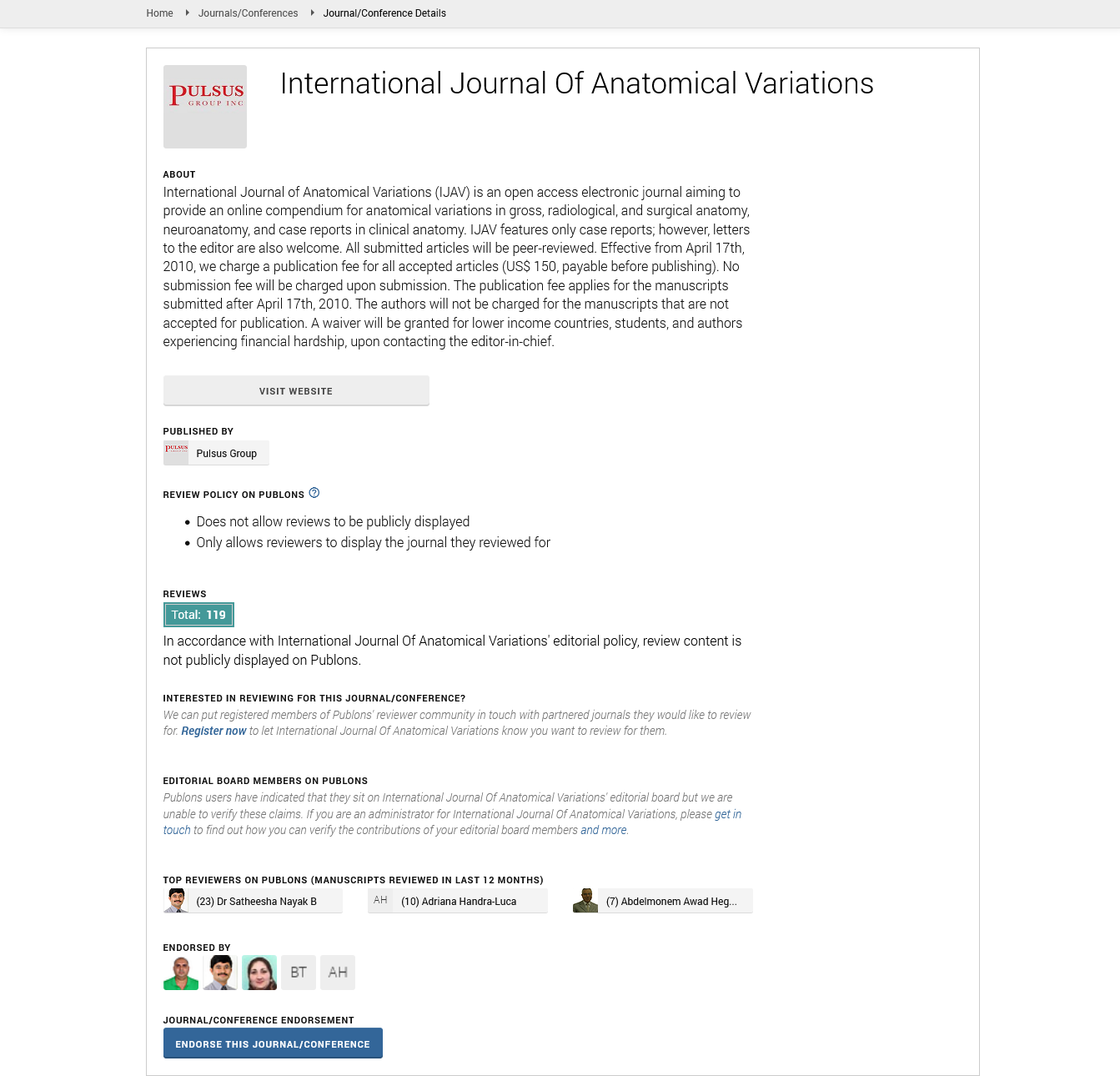Anatomical Anomalies a Comprehensive Review of Developmental and Acquired Variations in Human Anatomy
Received: 01-Feb-2025, Manuscript No. ijav-25-7619; Editor assigned: 04-Feb-2025, Pre QC No. ijav-25-7619 (PQ); Reviewed: 19-Feb-2025 QC No. ijav-25-7619; Revised: 26-Feb-2025, Manuscript No. ijav-25-7619 (R); Published: 28-Feb-2025, DOI: 10.37532/1308-4038.18(2).483
Citation: Kumar J. Anatomical Anomalies a Comprehensive Review of Developmental and Acquired Variations in Human Anatomy. Int J Anat Var. 2025;18(2): 734-734.
This open-access article is distributed under the terms of the Creative Commons Attribution Non-Commercial License (CC BY-NC) (http://creativecommons.org/licenses/by-nc/4.0/), which permits reuse, distribution and reproduction of the article, provided that the original work is properly cited and the reuse is restricted to noncommercial purposes. For commercial reuse, contact reprints@pulsus.com
Abstract
Anatomical anomalies represent deviations from the typical anatomical structure of the human body. These variations can be congenital or acquired and may range from benign to clinically significant. This article provides an in-depth review of the classification, causes, diagnostic approaches, and clinical implications of anatomical anomalies. Emphasis is placed on the importance of recognizing these variations in clinical practice, especially in surgery, radiology, and pathology. Through the integration of case studies and current literature, this research aims to enhance understanding and awareness of anatomical anomalies among medical professionals and researchers.
INTRODUCTION
Anatomical anomalies, also known as anatomical variations or abnormalities, are structural deviations from the norm in the human body. These deviations may be asymptomatic or may contribute to disease processes [1]. The understanding of anatomical anomalies is vital in clinical settings, as failure to recognize them can lead to diagnostic errors, surgical complications, or inappropriate treatment. Anatomy serves as the cornerstone of medical science, providing the essential framework for understanding human physiology, pathology, and surgical intervention. While the human body generally follows a consistent structural blueprint, deviations from this norm known as anatomical anomalies are not uncommon. These variations may be present at birth due to developmental irregularities or acquired later in life through disease, trauma, or surgical alteration. Although many anatomical anomalies are benign and asymptomatic, some can significantly impact clinical diagnosis, therapeutic strategies, and procedural outcomes. Anatomical anomalies encompass a broad spectrum of deviations, ranging from minor vascular or skeletal variations to complex malformations involving multiple organ systems. Their presence may complicate radiological interpretation, surgical planning, and even routine clinical examinations. Despite their clinical relevance [2], these variations are often under recognized or misinterpreted, leading to diagnostic delays or therapeutic complications. In this comprehensive review, we explore both developmental and acquired anatomical anomalies, delving into their etiology, classification, diagnostic approaches, and implications in clinical practice. By highlighting the importance of anatomical variation and incorporating insights from contemporary research and clinical case studies, this article aims to enhance medical awareness and inform best practices in the management of patients with atypical anatomical presentations.
CLINICAL IMPLICATIONS
Unrecognized anomalies can lead to complications such as bleeding, organ injury, or incomplete surgical outcomes. Preoperative imaging is crucial. Anomalies may mimic pathological conditions, leading to misdiagnosis. For instance, a bifid ureter might be mistaken for a ureteral obstruction. Endoscopic or catheter-based interventions may be complicated by anatomical variations, necessitating modification of standard techniques. An increased focus on anatomical variability in medical curricula can improve diagnostic accuracy and procedural safety [3].
CASE STUDIES
A 45-year-old male presented with abdominal pain; imaging revealed mirror-image positioning of thoracic and abdominal organs. Awareness of this anomaly was critical in avoiding misdiagnosis of appendicitis [4]. An elderly woman experienced dysphagia; CT angiography revealed an ARSA compressing the esophagus. Surgical correction alleviated symptoms [5].
CONCLUSION
Anatomical anomalies, whether congenital or acquired, are essential considerations in clinical medicine. Advances in imaging and genetic testing have improved detection rates, but awareness and education remain key. Recognizing these anomalies can significantly impact patient outcomes, reduce surgical risk, and guide personalized treatment.
FUTURE DIRECTIONS
Integrating AI in imaging for automated detection of anomalies. Genetic research to uncover the molecular basis of congenital anomalies. Global anomaly registries to track prevalence and improve research.
REFERENCES
- Pal M, Hailu A, Agarwal RK, Dave P (2013) recent developments in the diagnosis of rabies in humans and animals. JVPH 11: 77-82.
- Pieracci GE, Hall JA, Gharpure R, Haile A, Walelign E et al. (2016) Prioritizing zoonotic diseases in Ethiopia using a one health approach. One Health 2: 131-135.
- Quinn PJ, Markey BK, Leonard FC, Fitzpatrick ES, Fanning S et al. (2011) Veterinary Microbiology and Microbial Disease. 2nd ed. West Sussex, Wiley-Blackwell, Publishing. 551-553.
- Mengistu F, Hussen K, Getahun G, Sifer D, Ali A (2011) Short Communication Total case of dog bites to humans and seasonal patterns of the bites. Vet J 15:103-108.
- Meslin F-X, Briggs D J (2013) Eliminating canine rabies, the principal source of human infection: what will it take. Antiviral Res 98:291-296.
Indexed at, Google Scholar, Crossref






